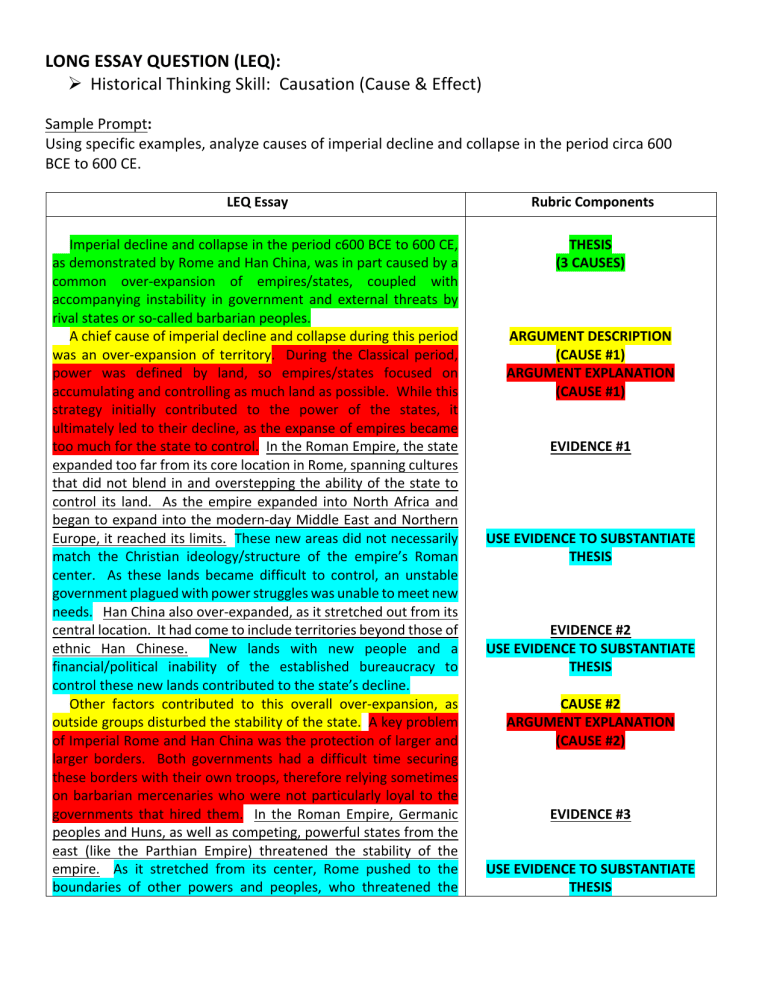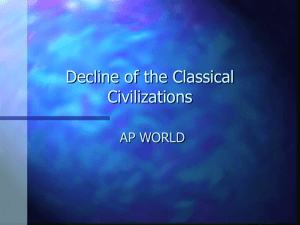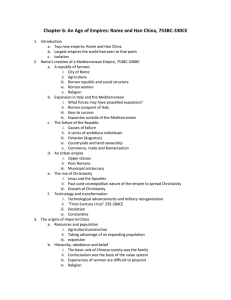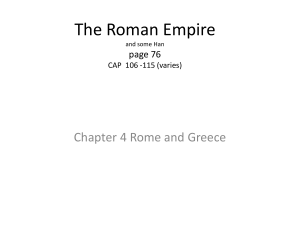
LONG ESSAY QUESTION (LEQ): Ø Historical Thinking Skill: Causation (Cause & Effect) Sample Prompt: Using specific examples, analyze causes of imperial decline and collapse in the period circa 600 BCE to 600 CE. LEQ Essay Rubric Components Imperial decline and collapse in the period c600 BCE to 600 CE, as demonstrated by Rome and Han China, was in part caused by a common over-expansion of empires/states, coupled with accompanying instability in government and external threats by rival states or so-called barbarian peoples. A chief cause of imperial decline and collapse during this period was an over-expansion of territory. During the Classical period, power was defined by land, so empires/states focused on accumulating and controlling as much land as possible. While this strategy initially contributed to the power of the states, it ultimately led to their decline, as the expanse of empires became too much for the state to control. In the Roman Empire, the state expanded too far from its core location in Rome, spanning cultures that did not blend in and overstepping the ability of the state to control its land. As the empire expanded into North Africa and began to expand into the modern-day Middle East and Northern Europe, it reached its limits. These new areas did not necessarily match the Christian ideology/structure of the empire’s Roman center. As these lands became difficult to control, an unstable government plagued with power struggles was unable to meet new needs. Han China also over-expanded, as it stretched out from its central location. It had come to include territories beyond those of ethnic Han Chinese. New lands with new people and a financial/political inability of the established bureaucracy to control these new lands contributed to the state’s decline. Other factors contributed to this overall over-expansion, as outside groups disturbed the stability of the state. A key problem of Imperial Rome and Han China was the protection of larger and larger borders. Both governments had a difficult time securing these borders with their own troops, therefore relying sometimes on barbarian mercenaries who were not particularly loyal to the governments that hired them. In the Roman Empire, Germanic peoples and Huns, as well as competing, powerful states from the east (like the Parthian Empire) threatened the stability of the empire. As it stretched from its center, Rome pushed to the boundaries of other powers and peoples, who threatened the THESIS (3 CAUSES) ARGUMENT DESCRIPTION (CAUSE #1) ARGUMENT EXPLANATION (CAUSE #1) EVIDENCE #1 USE EVIDENCE TO SUBSTANTIATE THESIS EVIDENCE #2 USE EVIDENCE TO SUBSTANTIATE THESIS CAUSE #2 ARGUMENT EXPLANATION (CAUSE #2) EVIDENCE #3 USE EVIDENCE TO SUBSTANTIATE THESIS expansive tactics of the Romans. In Han China, continuous conflicting powers and nomadic peoples (most notably the Xiongnu, or Huns), disturbed the careful stability of the Han dynasty’s centralized bureaucratic system. Both locations were simply unable to maintain stability as their precarious state from over-expansion met threats from outside and within. The northern nomadic peoples funneled into China despite efforts by the Han army and the Great Wall. The states themselves were also contributing factors to their decline, as many imperial states had not established a government strong enough for its ambitions. In the Roman Empire, a chronically conflicting central government under the leadership of weak emperors and a fragile bureaucracy met individuals (most often generals) battling to be emperor, which did not create a strong/stable center to control its wild ambitions in expansion. As a result, Roman citizens also began to question the imperial leadership and its ability to protect the empire’s economic interests. In Han China, a careful Confucian bureaucratic system was simply not strong enough, either, to meet expanding territory and threats to stability. Han China was not plagued by the same pattern of imperial assassinations as Rome, but the emperors proved to be as incompetent if not simply unable to reverse the trends of decline. From a different historical context, at a much later time period (the early 1800s) Napoleon’s state met similar causes of decline. While Napoleon’s wild ambition drove him to expand far beyond the stretches he was capable of maintaining, the stability of his power was compromised and reached a decline. In attempting to create a Europe-wide empire as well as an empire in the New World, he reached his limits. Imperial collapse/decline in the period c600 BCE to 600 CE was characterized by over-expansion as a key cause, accompanied by outside threats and internal weakness/instability of the government, as evident in the Roman Empire and Han China. EVIDENCE #4 EVIDENCE #5 ARGUMENT DESCRIPTION (CAUSE #3) EVIDENCE #6 USE EVIDENCE TO SUBSTANTIATE EVIDENCE EVIDENCE #7 EVIDENCE #8 SYNTHESIS THESIS (RE-WORKED)


